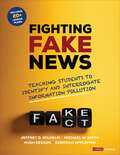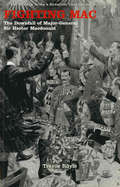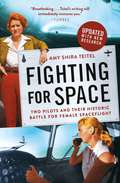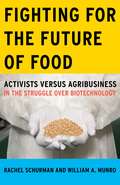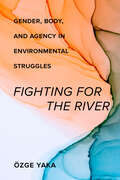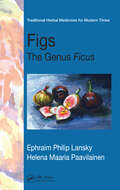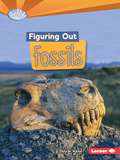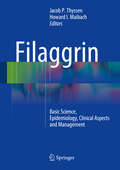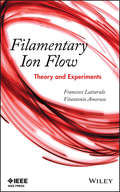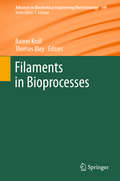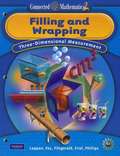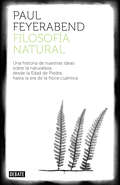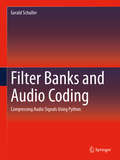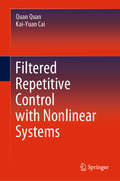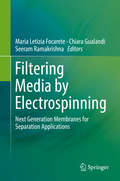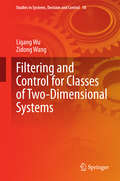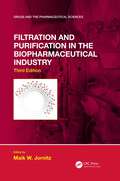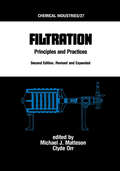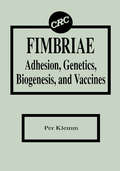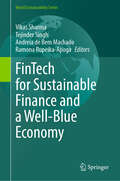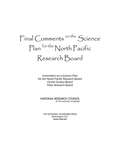- Table View
- List View
Fighting Fake News: Teaching Students to Identify and Interrogate Information Pollution (Corwin Literacy)
by Michael W. Smith Jeffrey D. Wilhelm Deborah Appleman Hugh KessonCritical thinking and online reading need to go hand in hand—but they often don’t. Students click, swipe, and believe because they don’t know how to do otherwise. At times, so do we. And that’s a problem. Fighting Fake News combats this challenge by helping you model how to read, myth-bust, truth-test, and respond in ways that lead to wisdom rather than reactivity. No matter what content you teach, the lessons showcased here provide engaging, collaborative reading and discussion experiences so students can: Notice how teacher and peers read digital content, to be mindful of how various reading pathways influence perception Identify the author background, the website sponsor, and other evidence that help set a piece in context Stress-test the facts by evaluating news sources, reading laterally, and other critical reading strategies Use "Reader’s Rules of Notice" to learn to identify common rhetorical devices used to influence the reader Be aware of how for-profit social media platforms feed on our responses to narrow rather than widen our reading landscape We are still in the wild west era of the digital age, scrambling to impart a safer, ethical framework for evaluating information. Thankfully, it distills to one mission: teach students (and ourselves) how to think critically, and we will forever have the tools to fight fake news.
Fighting Mac: The Downfall of Major-General Sir Hector Macdonald
by Trevor RoyleOn a spring morning in 1903, Major-General Sir Hector Macdonald, one of Britain's greatest military heroes, took his life in a hotel room in Paris. A few days later he was buried hastily in an Edinburgh cemetary as his fellow countrymen tried to come to terms with the fact that one of Scotland's most famous soldiers had ended his life rather than face charges against his character.The suicide and its aftermath created a national scandal and one which still reverberates long after those dramatic events - it is now clear that the official files dealing with his case, the papers of the Judge Advocate have been destroyed. Macdonald or 'Fighting Mac' as he was known to an adoring public, was no ordinary soldier. A crofter's son who had risen from the ranks in the Victorian army, he covered himself with glory during a long and successful military career and in 1898 was widely acknowledged as the true hero of the Battle of Omdurman, which cemented British Imperial rule in Anglo-Egyptian Sudan. Everything lay at his feet - a knighthood, honours, the respect of fellow generals such as Roberts and Kitchener - but Macdonald's career came to a shocking full stop when he stood accused of homosexuality and was ordered to face a court martial. Unable to come to terms with the disgrace, he committed suicide. That should have been the end of his story but so powerful was the myth created by Fighting Mac that people refused to believe he was dead. Soon rumours were circulating that Macdonald had faked his death and had adopted the persona of a prominent Prussian officer, the future Field Marshal August con Mackensen, one of Germany's great leaders during the First World War. FIGHTING MAC tells the true story behind his disgrace and sheds new light on the myths....
Fighting for Space: Two Pilots and Their Historic Battle for Female Spaceflight
by Amy TeitelSpaceflight historian Amy Shira Teitel tells the riveting story of the female pilots who each dreamed of being the first American woman in space. When the space age dawned in the late 1950s, Jackie Cochran held more propeller and jet flying records than any pilot of the twentieth century-man or woman. She had led the Women's Auxiliary Service Pilots during the Second World War, was the first woman to break the sound barrier, ran her own luxury cosmetics company, and counted multiple presidents among her personal friends. She was more qualified than any woman in the world to make the leap from atmosphere to orbit. Yet it was Jerrie Cobb, twenty-five years Jackie's junior and a record-holding pilot in her own right, who finagled her way into taking the same medical tests as the Mercury astronauts. The prospect of flying in space quickly became her obsession. While the American and international media spun the shocking story of a "woman astronaut" program, Jackie and Jerrie struggled to gain control of the narrative, each hoping to turn the rumored program into their own ideal reality-an issue that ultimately went all the way to Congress. This dual biography of audacious trailblazers Jackie Cochran and Jerrie Cobb presents these fascinating and fearless women in all their glory and grit, using their stories as guides through the shifting social, political, and technical landscape of the time.
Fighting for the Future of Food: Activists versus Agribusiness in the Struggle over Biotechnology (Social Movements, Protest and Contention #35)
by William A. Munro Rachel SchurmanWhen scientists working in the agricultural biotechnology industry first altered the genetic material of one organism by introducing genes from an entirely different organism, the reaction was generally enthusiastic. To many, these genetically modified organisms (GMOs) promised to solve the challenges faced by farmers and to relieve world hunger. Yet within a decade, this &“gene revolution&” had abruptly stalled. Widespread protests against the potential dangers of &“Frankenfoods&” and the patenting of seed supplies in the developing world forced the industry to change course. As a result, in the late 1990s, some of the world&’s largest firms reduced their investment in the agricultural sector, narrowed their focus to a few select crops, or sold off their agricultural divisions altogether.Fighting for the Future of Food tells the story of how a small group of social activists, working together across tables, continents, and the Internet, took on the biotech industry and achieved stunning success. Rachel Schurman and William A. Munro detail how the anti-biotech movement managed to alter public perceptions about GMOs and close markets to such products. Drawing strength from an alternative worldview that sustained its members&’ sense of urgency and commitment, the anti-GMO movement exploited political opportunities created by the organization and culture of the biotechnology industry itself. Fighting for the Future of Food ultimately addresses society&’s understanding and trust (or mistrust) of technological innovation and the complexities of the global agricultural system that provides our food.
Fighting for the River: Gender, Body, and Agency in Environmental Struggles
by Özge YakaFighting for the River portrays women's intimate, embodied relationships with river waters and explores how those relationships embolden local communities' resistance to private run-of-the-river hydroelectric power plants in Turkey. Building on extensive ethnographic research, Özge Yaka develops a body-centered, phenomenological approach to women's environmental activism and combines it with a relational ontological perspective. In this way, the book pushes beyond the "natural resources" frame to demonstrate how our corporeal connection to nonhuman entities is constitutive of our more-than-human lifeworld. Fighting for the River takes the human body as a starting point to explore the connection between lived experience and nonhuman environments, treating bodily senses and affects as the media of more-than-human connectivity and political agency. Analyzing local environmental struggles as struggles for coexistence, Yaka frames human-nonhuman relationality as a matter of socio-ecological justice.
Fighting the Great War at Sea: Strategy, Tactic and Technology
by Norman FriedmanWinner of the John Lyman Book Award for Naval and Maritime Science and Technology. &“A compelling and convincing historical analysis of World War I.&” —Navy News While the overriding image of the First World War is of the bloody stalemate on the western front, the overall shape of the war arose out of its maritime character. It was essentially a struggle about access to worldwide resources, most clearly seen in Germany&’s desperate attempts to counter the American industrial threat, which ultimately drew the United States into the war. This radical new book concentrates on the way in which each side tried to use or deny the sea to the other, and in so doing, describes rapid wartime changes not only in ship and weapons technology but also in the way naval warfare was envisaged and fought. Melding strategic, technical, and tactical aspects, Friedman approaches the First World War from a fresh perspective and demonstrates how its perceived lessons dominated the way navies prepared for the Second World War. &“Friedman is a master of the evolution of naval strategy, tactics and technology . . . a rewarding read that will leave many wanting to return again and again just to see what they might have missed the first time.&” —Australian Naval Institute &“Dr. Friedman&’s research credentials are impeccable, and the huge amount of factual detail he has unearthed will be sure to delight many . . . there is nothing comparable in either depth or scope out there, and for this reason, if no other, this book is likely to become a standard work on the naval aspects of the Great War.&” —Naval War College Review
Figs: The Genus Ficus (Traditional Herbal Medicines for Modern Times)
by Helena Maaria Paavilainen Ephraim Philip LanskyWith a history as ancient as any cultivated fruit, many believe the fig has been with us even longer than the pomegranate. The Ficus constitutes one of the largest and hardiest genera of flowering plants featuring as many as 750 species. Although the extraordinary mutualism between figs and their pollinating wasps has received much attention, the p
Figuring Out Fossils (Searchlight Books - Do You Dig Earth Science?)
by Sally M. WalkerFossils give us a window to the past. Water, sediments, and pressure work together over time to preserve the shape of things that lived long ago. Studying these ancient plants and animals tells us more about our own existence. Have you ever searched for fossils? Unearth some in this book.
Filaggrin
by Howard I. Maibach Jacob P. ThyssenFilaggrin gene mutations are common in Europeans and their descendants, as well as in Asians, reaching a prevalence of up to 10%. Filaggrin proteins are crucial for skin homeostasis as their metabolites maintain skin hydration, keep the skin pH low, and provide protection against solar radiation. FLG mutation carriers suffer from dry and scaly skin and have an increased transfer of allergens and chemicals across the epidermis. Moreover, they have 10% higher serum vitamin D levels, potentially affecting the propensity to develop other diseases. FLG loss-of-function mutations represent the strongest risk factor hitherto discovered for atopic dermatitis and are major predisposing factors for related asthma and hay fever. This textbook provides comprehensive and detailed coverage of the effects of FLG mutations in health and disease (cutaneous and non-cutaneous) and also discusses the basic science, epidemiology, management, and future research areas.
Filamentary Ion Flow: Theory and Experiments
by Vitantonio Amoruso Francesco LattaruloPresents all-new laboratory-tested theory for calculating more accurate ionized electric fields to aid in designing high-voltage devices and its components Understanding and accurately calculating corona originated electric fields are important issues for scientists who are involved in electromagnetic and electrostatic studies. High-voltage dc lines and equipment, in particular, can generate ion flows that can give rise to environmental inconveniences. Filamentary Ion Flow: Theory and Experiments provides interdisciplinary theoretical arguments to attain a final model for computational electrostatics in the presence of flowing space charge. Based on years of extensive lab tests pertaining to the physical performance of unipolar corona ion flows, the book covers the enlarging of conventional electrostatic applications, which allows for some emerging and uncharted interests to be explored. Filamentary Ion Flow: Examines the theoretical discussions for creating a model of computational electrostatics involved with flowing space charges Presents new theory and experimental data based on extensive testing Offers potential design applications utilizing the theory Helps scientists who are involved in electromagnetic and electrostatic studies understand and accurately calculate corona originated ion flow fields Filamentary Ion Flow: Theory and Experiments is ideal for electrical engineers and research scientists interested in high-voltage technology, computational electrostatics, and electromagnetic theory.
Filaments in Bioprocesses
by Rainer Krull Thomas BleyThis book review series presents current trends in modern biotechnology. The aim is to cover all aspects of this interdisciplinary technology where knowledge, methods and expertise are required from chemistry, biochemistry, microbiology, genetics, chemical engineering and computer science. Volumes are organized topically and provide a comprehensive discussion of developments in the respective field over the past 3-5 years. The series also discusses new discoveries and applications. Special volumes are dedicated to selected topics which focus on new biotechnological products and new processes for their synthesis and purification. In general, special volumes are edited by well-known guest editors. The series editor and publisher will however always be pleased to receive suggestions and supplementary information. Manuscripts are accepted in English.
Filling and Wrapping, Three-Dimensional Measurement
by Glenda Lappan James T. Fey William M. Fitzgerald Susan N. Friel Elizabeth Difanis PhillipsNIMAC-sourced textbook
Filling and Wrapping: Three-Dimensional Measurement
by Glenda Lappan James T. Fey Susan N. Friel Elizabeth Difanis PhillipsNIMAC-sourced textbook
Filosofía natural: Una historia de nuestras ideas sobre la naturaleza
by Paul FeyerabendUna historia de nuestras ideas sobre la naturaleza desde la Edad de Piedra hasta la era de la física cuántica. La obra póstuma de Paul Feyerabend, uno de los filósofos más importantes del siglo XX. Paul Feyerabend fue uno de los científicos más originales y controvertidos de su tiempo. Su «todo vale» se ha convertido en un lema, y la claridad en la exposición de sus ideas atrajo al público dentro y fuera de las universidades. Filosofía natural pretende reconstruir la historia de las concepciones humanas de la naturaleza desde sus primeras expresiones en las pinturas rupestres de la Edad de Piedra hasta las discusiones del siglo XX sobre física nuclear. Publicada con más de treinta años de retraso, fue concebida originalmente como una obra en tres tomos que nunca llegaron a escribirse. El manuscrito se dio por perdido durante mucho tiempo, hasta que una copia mecanografiada apareció en los archivos de la Universidad de Constanza. Paul Feyerabend examina el significado de los mitos desde los albores de la filosofía natural hasta Parménides, y centra sus reflexiones en el crecimiento devastador del racionalismo durante la antigüedad griega y la consecuente separación del hombre y la naturaleza. Reseña:«El texto póstumo de Paul Feyerabend animará a buscar una nueva interpretación de la naturaleza y una mejor forma de vivir.»Neue Zürcher Zeitung
Filter Banks and Audio Coding: Compressing Audio Signals Using Python
by Gerald SchullerThis textbook presents the fundamentals of audio coding, used to compress audio and music signals, using Python programs both as examples to illustrate the principles and for experiments for the reader. Together, these programs then form complete audio coders. The author starts with basic knowledge of digital signal processing (sampling, filtering) to give a thorough introduction to filter banks as used in audio coding, and their design methods. He then continues with the next core component, which are psycho-acoustic models. The author finally shows how to design and implement them. Lastly, the author goes on to describe components for more specialized coders, like the Integer-to-Integer MDCT filter bank, and predictive coding for lossless and low delay coding. Included are Python program examples for each section, which illustrate the principles and provide the tools for experiments.Comprehensively explains the fundamentals of filter banks and audio coding;Provides Python examples for each principle so that completed audio coders are obtained in the language;Includes a suite of classroom materials including exercises, experiments, and examples.
Filterbänke und Audiocodierung: Komprimierung von Audiosignalen mit Python
by Gerald SchullerDieses Lehrbuch stellt die Grundlagen der Audiocodierung vor, die zur Komprimierung von Audio- und Musiksignalen verwendet wird. Dabei werden Python-Programme sowohl als Beispiele zur Veranschaulichung der Prinzipien als auch für Experimente für den Leser verwendet. Zusammen bilden diese Programme dann komplette Audiocodierer. Der Autor beginnt mit grundlegenden Kenntnissen der digitalen Signalverarbeitung (Abtastung, Filterung), um eine gründliche Einführung in Filterbänke, wie sie in der Audiocodierung verwendet werden, und deren Entwurfsmethoden zu geben. Er fährt dann mit der nächsten Kernkomponente fort, den psycho-akustischen Modellen. Der Autor zeigt schließlich, wie man sie entwirft und implementiert. Schließlich beschreibt der Autor Komponenten für speziellere Kodierer, wie die Integer-to-Integer MDCT-Filterbank und prädiktive Kodierung für verlustfreie und verzögerungsarme Kodierung. Zu jedem Abschnitt gibt es Python-Programmbeispiele, die die Prinzipien veranschaulichen und die Werkzeuge für Experimente bereitstellen. Umfassende Erläuterung der Grundlagen von Filterbänken und Audiocodierung; Bietet Python-Beispiele für jedes Prinzip, so dass fertige Audiocodierer in der Sprache erhalten werden; Enthält eine Reihe von Unterrichtsmaterialien mit Übungen, Experimenten und Beispielen.
Filtered Repetitive Control with Nonlinear Systems
by Quan Quan Kai-Yuan CaiThough there have been significant advances in the theory and applications of linear time-invariant systems, developments regarding repetitive control have been sporadic. At the same time, there is a dearth of literature on repetitive control (RC) for nonlinear systems.Addressing that gap, this book discusses a range of basic methods for solving RC problems in nonlinear systems, including two commonly used methods and three original ones. Providing valuable tools for researchers working on the development of repetitive control, these new and fundamental methods are one of the major features of the book, which will benefit researchers, engineers, and graduate students in e.g. the field of control theory.
Filtering Media by Electrospinning: Next Generation Membranes For Separation Applications
by Seeram Ramakrishna Chiara Gualandi Maria Letizia FocareteThis book covers the state-of-the-art on electrospun materials for the use of filters for water remediation, ion-exchange membranes and affinity membranes for the capture of selected chemical and biochemical species, as well as filtering applications covering air treatment, defense and protective applications, and oil-water separation. The book also provides an overview of the landscape of marketed electrospun filters and of technical approaches for the large scale production of nanofibrous non-woven filter media. This is an ideal book for biomaterials and polymer researchers interested in the applications of filtering media by electrospinning.This book also:Covers the latest research on ion-exchange membranes and affinity membranes for capture of cells and biological substancesBroadens reader understanding of antimicrobial electrospun filters and sieving filters for liquid microfiltrationReviews exhaustively the key recent research into electrospun filters for oil-water separation, heavy metals removal, and defense and protective applications
Filtering and Control for Classes of Two-Dimensional Systems
by Zidong Wang Ligang WuThis book focuses on filtering, control and model-reduction problems for two-dimensional (2-D) systems with imperfect information. The time-delayed 2-D systems covered have system parameters subject to uncertain, stochastic and parameter-varying changes. After an initial introduction of 2-D systems and the ideas of linear repetitive processes, the text is divided into two parts detailing: · General theory and methods of analysis and optimal synthesis for 2-D systems; and · Application of the general theory to the particular case of differential/discrete linear repetitive processes. The methods developed provide a framework for stability and performance analysis, optimal and robust controller and filter design and model approximation for the systems considered. Solutions to the design problems are couched in terms of linear matrix inequalities. For readers interested in the state of the art in linear filtering, control and model reduction, Filtering and Control for Classes of Two-Dimensional Systems will be a useful reference for exploring the field of 2-D systems either from a purely theoretical research perspective or from the point of view of a multitude of potential applications including image processing, and the study of seismographic data or thermal processes.
Filtering and System Identification
by Michel Verhaegen Vincent VerdultFiltering and system identification are powerful techniques for building models of complex systems. This 2007 book discusses the design of reliable numerical methods to retrieve missing information in models derived using these techniques. Emphasis is on the least squares approach as applied to the linear state-space model, and problems of increasing complexity are analyzed and solved within this framework, starting with the Kalman filter and concluding with the estimation of a full model, noise statistics and state estimator directly from the data. Key background topics, including linear matrix algebra and linear system theory, are covered, followed by different estimation and identification methods in the state-space model. With end-of-chapter exercises, MATLAB simulations and numerous illustrations, this book will appeal to graduate students and researchers in electrical, mechanical and aerospace engineering. It is also useful for practitioners. Additional resources for this title, including solutions for instructors, are available online at www. cambridge. org/9780521875127.
Filtration and Purification in the Biopharmaceutical Industry, Third Edition (Drugs and the Pharmaceutical Sciences)
by Maik W. JornitzSince sterile filtration and purification steps are becoming more prevalent and critical within medicinal drug manufacturing, the third edition of Filtration and Purification in the Biopharmaceutical Industry greatly expands its focus with extensive new material on the critical role of purification and advances in filtration science and technology. It provides state-of-the-science information on all aspects of bioprocessing including the current methods, processes, technologies and equipment. It also covers industry standards and regulatory requirements for the pharmaceutical and biopharmaceutical industries. The book is an essential, comprehensive source for all involved in filtration and purification practices, training and compliance. It describes such technologies as viral retentive filters, membrane chromatography, downstream processing, cell harvesting, and sterile filtration. Features: Addresses recent biotechnology-related processes and advanced technologies such as viral retentive filters, membrane chromatography, downstream processing, cell harvesting, and sterile filtration of medium, buffer and end product Presents detailed updates on the latest FDA and EMA regulatory requirements involving filtration and purification practices, as well as discussions on best practises in filter integrity testing Describes current industry quality standards and validation requirements and provides guidance for compliance, not just from an end-user perspective, but also supplier requirement It discusses the advantages of single-use process technologies and the qualification needs Sterilizing grade filtration qualification and process validation is presented in detail to gain the understanding of the regulatory needs The book has been compilated by highly experienced contributors in the field of pharmaceutical and biopharmaceutical processing. Each specific topic has been thoroughly examined by a subject matter expert.
Filtration: Principles and Practices, Second Edition, Revised and Expanded
by MattesonCompletely revised and updated, this Second Edition of the critically acclaimed referenceprovides the very latest theoretical and practical data on filtration of gases and liquids.Filtration: Principles and Practices, Second Edition, Revised and Expanded features severalall-new chapters which detail filtration in the mineral industry, high-efficiency air filtration,cartridge filters, and ultrafiltration.The most authoritative and comprehensive guide to essential, state-of-the-art data, Filtration:Principles and Practices, Second Edition, Revised and Expanded is an indispensable referencefor industrial process and chemical engineers and scientists engaged in research, development,and production in the chemical, mineral, food, beverage, and pharmaceutical industries. Itis also a valuable reference for upper-level undergraduate and graduate students in chemicalengineering courses in unit operations.
Fimbriae Adhesion, Genetics, Biogenesis, and Vaccines
by Per KlemmFimbriae are the best-studied bacterial colonization factors. They are of paramount importance in bacterial pathogenesis and microbial ecology. Due to the advent of new and powerful techniques, an impressive amount of information has been accumulated on these important surface organelles over the last decade. The first book of its kind, Fimbriae brings together into one volume the state of the art of this very active field. Internationally recognized researchers give both a horizontal and lateral approach to fimbriology. Selected types of fimbriae are extensively reviewed and fundamental questions such as evolution, control or regulation, biogenesis, bacteria-host interaction, and fimbriae-based vaccines are examined.
FinTech for Sustainable Finance and a Well-Blue Economy (World Sustainability Series)
by Ramona Rupeika-Apoga Vikas Sharma Andreia de Bem Machado Tejinder SinghThis book explores how financial technology (FinTech) can drive sustainable practices within the blue economy, which revolves around the responsible use of ocean and water-based resources. It highlights how innovations such as blockchain, artificial intelligence (AI), and digital finance can promote environmental sustainability, economic growth, and social equity. By integrating these technologies, the book provides insights into building resilient, well-managed ecosystems that contribute to a stable and prosperous world economy. The blue economy includes sectors like fisheries, aquaculture, tourism, shipping, and marine renewable energy, all of which require sustainable resource management to thrive. FinTech offers new ways to align financial flows with sustainability goals, channelling investments into eco-friendly marine projects and creating microfinance opportunities for coastal communities. The book emphasizes how green financing, supported by FinTech platforms, can mobilize capital for sustainable initiatives such as marine conservation and renewable energy production. A significant focus of the book is the role of blockchain and AI in enhancing transparency and efficiency. Blockchain helps trace supply chains, reducing illegal fishing and promoting sustainable sourcing, while AI supports predictive tools for resource management and operational efficiency in industries like aquaculture. These technologies enable stakeholders to make data-driven decisions that foster both environmental preservation and economic profitability. The social dimension is also critical, as the book discusses how FinTech can promote financial inclusion in vulnerable coastal communities. Digital finance tools, such as mobile banking and peer-to-peer lending platforms, empower small businesses and individuals, creating sustainable livelihoods aligned with ocean conservation. Governance and policy frameworks are explored, showing how FinTech can enhance transparency, accountability, and cooperation between public and private sectors. The book examines how governments, financial institutions, and technology providers can design policies that encourage responsible economic practices while protecting marine ecosystems.
Final Comments on the Science Plan for the North Pacific Research Board
by National Research Council of the National AcademiesThe North Pacific Research Board (NPRB) was established by Congress in 1997 to recommend marine research activities to the Secretary of Commerce on or relating to the fisheries or marine ecosystem in the North Pacific Ocean, Bering Sea, Arctic Ocean, and related bodies of water. NPRB called on the National Academies to develop a comprehensive long range science plan pertaining to its research activities. This assistance has been provided in two phases. In phase one, beginning in early 2003, a National Academies committee worked to understand the purpose of the NPRB, gather information to help identify research needs, and provide advice on the components of a sound science plan. The committee's assessment is contained in a report released in early 2004, Elements of a Science Plan for the North Pacific Research Board. With this guidance as a tool, the NPRB staff, Science Panel, and Advisory Panel worked together to write a draft science plan to steer the program in the coming decade. During the second phase, the same committee reviewed the NPRB's draft science plan and provided final feedback to the NPRB. It is a focused review, generally following the organization of the NPRB document. This report is intended primarily as a direct communication from the committee to those planning the NPRB's programs, to help them improve the science plan and ensure successful implementation.
